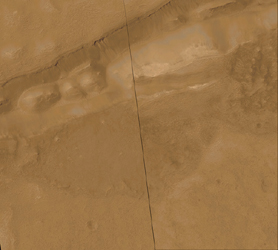

MGS MOC Release No. MOC2-243, 22 June 2000

25%-size Color 250 KBytes |
The mosaic was constructed from two pictures taken on September 16, 1999, and May 1, 2000. The black line is a gap between the two images that was not covered by MOC. The scene covers an area approximately 5.5 kilometers (3.4 miles) wide by 4.9 km (3.0 mi) high. Sunlight illuminates the area from the upper left. The image is located near 38.5°S, 171.3°W. MOC high resolution images are taken black-and-white (grayscale); the color seen here has been synthesized from the colors of Mars observed by the MOC wide angle cameras and by the Viking Orbiters in the late 1970s.
Images Credit: NASA/JPL/Malin Space Science Systems
The MOC narrow angle camera only takes grayscale (black and white) pictures. To create the color versions seen here, we have taken much lower resolution red and blue images acquired by the MOC's wide angle cameras, and by the Viking Orbiter cameras in the 1970s, synthesized a green image by averaging red and blue, and created a pallete of colors that represent the range of colors on Mars. We then use a relationship that correlates color and brightness to assign a color to each gray level. This is only a crude approximation of martian color and should only be considered representative of Mars. It is likely Mars would not look like this to a human observer at Mars.
Malin Space Science Systems and the California Institute of Technology built the MOC using spare hardware from the Mars Observer mission. MSSS operates the camera from its facilities in San Diego, CA. The Jet Propulsion Laboratory's Mars Surveyor Operations Project operates the Mars Global Surveyor spacecraft with its industrial partner, Lockheed Martin Astronautics, from facilities in Pasadena, CA and Denver, CO.